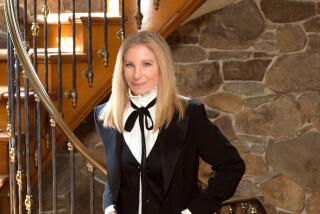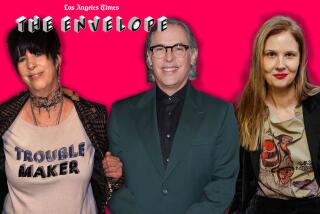Remembering Mastroianni
There’s never been a film quite like “Marcello Mastroianni: I Remember,” a 195-minute portrait of the late actor looking back on his life and career that incorporates entire sequences from films he considered significant, some of them classics like “La Dolce Vita,” others neglected masterpieces like “The Organizer,” in which Mastroianni played an idealistic 19th century labor unionist, and some simply obscure. “I Remember” unfolds leisurely yet engrossingly as if by free association.
“Many, many TV people around the world wanted to do profiles on Marcello, but he would say, ‘No, no, I don’t like it,” recalled Anna Maria Tato, Mastroianni’s companion of 22 years and the maker of “I Remember,” which opens Friday at the Music Hall (9036 Wilshire Blvd., Beverly Hills, [310] 274-6869).
Tato has made some 70 documentary profiles of filmmakers and artists. “One evening we were looking at my profile of Orson Welles, and he said, ‘Why don’t we do one together?’ Nobody would be asking him questions he didn’t want to answer; he didn’t want to speak about private things.”
Meeting Tato, it is easy to understand Mastroianni’s attraction. She is a lovely looking woman, 40-something, with dark auburn hair, an olive complexion and a radiant smile. She is woman of strong, impassioned opinions, tremendous vitality and humor who has lived a full life of professional accomplishment that has given her a clear sense of her own identity. Talking about Mastroianni and their film recently in a conference room at First Look Pictures, “I Remember’s” American distributor, Tato allowed that there was a lot of conflict in their relationship but added, “I think that’s healthy.”
Tato strived and succeeded in bringing a sense of balance to her portrait of Mastroianni, capturing both his durable charm and his capacity for reflection. She is likewise engaged in a personal balancing act: She appreciates recognition as a person of consequence in her own right, yet once you’ve gotten her to open up a bit about her childhood and youth in Southern Italy, she insists on placing the focus back on Mastroianni. What she has to say about herself is droll and captivating, but it’s quickly dismissed and held off the record. Understandably, she’s not too keen on commenting at length about the other women who were important in Mastroianni’s life--and not at all on the record.
Tato and Mastroianni began their film collaboration not a moment too soon, deciding that she would get him to talk--”I really pushed him,” she said--during the shooting of what would prove to be his final film, Manoel de Oliveira’s “Voyage to the Beginning of the World,” in which Mastroianni played a director who has returned to his native Portugal for the first time in many years to shoot a film. “Marcello loved to travel--traveling was very important to him--and we thought that the mountains, the landscapes of Portugal would be a very good background.”
Tato rounded up a small crew of old friends, headed by renowned cinematographer Giuseppe Rotunno, who would be able to shoot fast--there was no time for second takes--and unobtrusively between Mastroianni’s scenes for Oliveira. A lot of his talking in fact takes place in transit, which gives the film a sense of constant flow, and of a life unfolding. Mastroianni insisted that whole sequences from his films, not just clips, would be used. The idea was to give as much breadth and depth as possible to the actor and the man, who was above all concerned with skewering the Latin-lover image that “La Dolce Vita” had given him.
Mastroianni had too much charisma, on screen and off, had been linked to too many beautiful women, again on screen and off, to hope to escape that stereotype, but 9he and Tato do a terrific job moving beyond it to show us the man who could take his art seriously without taking himself too seriously. An actor of tremendous range and versatility, he reached out and embraced the world joyously instead of indulging in self-absorption. He was proud of his humble roots as the son and grandson of carpenters and he loved his profession.
“Marcello really was loved by everybody,” said Tato with the bemused weariness and resignation of a woman who has had to share her lover with the world. She twice mentioned that he was not without defects but was not about to enumerate them. She discovered early on that he was not a fake in that the virtually universal affection he inspired was authentic. Tato has been a film journalist, edited and designed series of film books and organized cultural events in connection with the release of various major European films before becoming a filmmaker. She became acquainted with Mastroianni when in 1978 director Marco Ferreri permitted her to make a film about the making of “Bye Bye Monkey,” which he shot in New York with Mastroianni and Gerard Depardieu.
While Ferreri, her good friend, was crucial in bringing her and Mastroianni together, it was another friend, none other than Federico Fellini, who gave her a crucial piece of advice: “Remember, Marcello is one of the most intelligent men I have ever met. Don’t underestimate him.” Tato pointed out that “it’s not hard to be erudite--anybody can read lots of books, but the important thing is to read deeply,” referring to sequences in which Mastroianni discusses Chekhov at length with much appreciation and understanding.
Tato and Mastroianni lived principally in the handsome Paris flat where he died Dec. 19, 1996, of cancer at the age of 72. This “man of Rome,” who was born in Fontana Liri, a town not far from the Eternal City, preferred living primarily in Paris, said Tato, because “Paris is more discreet. He could go out and get a baguette in Paris without anyone bothering him. That would not be possible in Rome. Also his daughter [Chiara, whose mother is Catherine Deneuve] lives there, and he wanted to be near her. He was a good father.”
By October 1996, Tato had completed filming more than seven hours of footage with Mastroianni, and he saw all of it--twice. He went to Italy on tour in “The Last Moons,” a play about heartbreak and old age, which Tato said was the country’s biggest theatrical success in 20 years. “He gave his last performance on Nov. 6, which meant that he was working less than two months before his death.”
After getting past the demands of arranging memorials both in Paris and Rome for so major and beloved a figure as Mastroianni, Tato set about editing her film, incorporating the sequences she and Mastroianni had agreed upon and discovering such tantalizing archival material as a tango number from the stage musical “Ciao, Rudy,” in which Mastroianni played another legend, Rudolph Valentino.
She pressed on, encouraged by Ferreri (who would succumb to a heart attack in May 1997), who told her that she had a duty to complete “I Remember,” which went on that year to premiere in a 95-minute version in Cannes, win a prize at Venice in its full-length version and play to an enraptured full house at the New York Film Festival in Lincoln Center’s Avery Fisher Hall.
Whether the release of “I Remember” will open doors in America for Tato’s previous work, which includes several feature films, remains to be seen. In any event, she’s not looking back.
“Now I want to do long profiles on Fellini, Ferreri and Sergio Leone.” She also admits to wanting to be a little lazy, too, enjoying a nice meal in a pleasant setting, and savoring good wine. “This is life, too.”
More to Read
The biggest entertainment stories
Get our big stories about Hollywood, film, television, music, arts, culture and more right in your inbox as soon as they publish.
You may occasionally receive promotional content from the Los Angeles Times.










